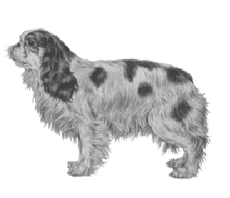King Charles Spaniel
General Information - King Charles Spaniel

Group:
Toy
Size:
Small
Lifespan:
10-12 years
Exercise:
Little
Grooming:
Moderate
Trainability:
Moderate
Watchdog Ability:
High
Protection Ability:
Very low
Area of Origin:
England
Date of Origin:
1600s
Other Names:
English Toy Spaniel
Original Function:
Flushing small birds,
lapdog
History
The King Charles Spaniel's origins probably trace back to Asian spaniels and perhaps the Pug, however the breed was primarily developed in the British Isles. This loving companion dog became a darling of the British royalty. The breed is named for King Charles II of England who owned quite a few of these charming little 'comforter' dogs. During the nineteenth century, the King Charles Spaniel underwent several changes. He was bred smaller, with flattened, upturned face, protruding eyes, and a more rounded skull. The result is today's King Charles Spaniel. The somewhat similar Cavalier King Charles Spaniel is based on the pre-nineteenth century King Charles.
Temperament
This sweet and gentle breed may be somewhat timid but responds well to affection. The King Charles Spaniel is the epitome of a lap dog and loves being around lots of people. Well behaved and generally quiet, King Charles Spaniels are average barkers. They can be somewhat stubborn.
Upkeep
Although it enjoys a nice walk on leash or a fun game in the house or yard, the King Charles Spaniel is not overly active and its exercise needs can be met with minimal effort. It does not do well in heat and is temperamentally unsuited for living outside away from its family. Its long coat needs combing twice weekly.
King Charles Spaniel
A breed standard is the guideline which describes the ideal characteristics, temperament, and appearance of a breed and ensures that the breed is fit for function with soundness essential. Breeders and judges should at all times be careful to avoid obvious conditions and exaggerations, as well as being mindful of features which could be detrimental in any way to the health, welfare or soundness of this breed.
Breed Standard - King Charles Spaniel
 General Appearance:
General Appearance: Compact and cobby, on refined lines, chest wide and deep, legs short and straight, back short and level. Tail well flagged, and not carried over the level of the back. Customarily docked. Movement free, active and elegant.
Head and Skull: Skull massive in comparison to size, well domed, and full over the eyes. Nose black with large wide open nostrils, very short and turned up to meet the skull. The stop between skull and nose should be well defined. Jaw; muzzle square, wide, deep and well turned up, lower jaw wide, lips exactly meeting, giving a nice finish. The cheeks should not fall away under the eyes, but be well cushioned up. A protruding tongue is objectionable, but does not disqualify.
Eyes: Very large and dark, set wide apart, with eyelids block square to face line, and with pleasing expression.
Ears: Set on low, and to hang quite flat to cheeks, very long and well feathered.
Coat: Long, silky and straight, a slight wave allowed, not curly. The legs, ears and tail should be profusely feathered.
Colour:
- Black and Tan - A rich glossy black, with bright, mahogany tan markings, on muzzle, legs, chest, linings of ears, under tail, and spots over eyes.
- TriColour - Ground pearly white and well distributed black patches, brilliant tan markings on cheeks, linings of ears, under tail, and spots over the eyes. A wide white blaze between the eyes, and up the forehead.
- Blenheim - A ground of pearly white with well distributed chestnut patches. A wide clear blaze with the “spot” in centre of skull. The “spot” should be a clear chestnut red mark about the size of a sixpence in centre of skull.
- Ruby - Whole coloured, a rich chestnut red.
Weight and Size: The most desirable size is 3.6 to 6.3 kg. (8 - 14 lbs).
Faults: The presence of a few white hairs on the chest of a Black and Tan or Ruby is undesirable, but a white patch is a major fault.
Note: Male animals should have two apparently normal testicles fully descended into the scrotum.
DNZ No 136
Copyright Dogs New Zealand
19 Dec 2013
Any departure from the foregoing points should be considered a fault and the seriousness with which the fault should be regarded should be in exact proportion to its degree and its effect upon the health and welfare of the dog and on the dog’s ability to perform its traditional work.




